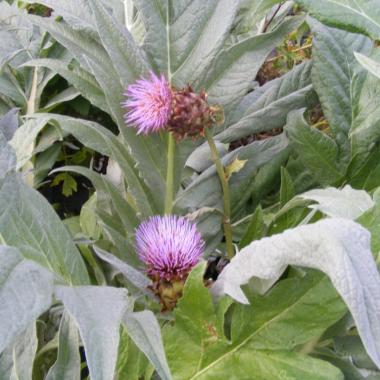


Cardoon
Cynara cardunculus
Both the leaves and the unopened flower buds can be harvested for culinary purposes and they have extensive medicinal uses.

This is a giant perennial herb with long serrated silvery grey leaves up to 80 cm long.
Large purple thistle like flowers are produced in August and September, these are great for pollinators,
attracting a multitude of insects to the blooms.
They are short lived perennial herbs grown mainly for their ornamental properties.
Cardoons are best planted in spring and early summer so that they can reach their full height and flower before the end of the season.
Although cardoons will grow in most soils they do best in full sun with a deep rich moist soil.
For culinary purposes they tend to be treated as annuals, and harvested from the end of the summer and into the autumn and early winter.
The Italians love cardoons as a vegetable as do the French and North African nations.
Cardoons do take a fair bit of preparation but the result is well worthwhile.
First harvest your cardoon plants and discard the base and any badly damaged outer stems.
Surprisingly the best tasting stems are the coarser outer ones,
the smaller more delicate inner foliage is very bitter so don't be tempted to use this.
Have a bowl ready with cold water and a good dash of lemon juice.
Remove the silver foliage and think of each stem as a large celery stalk and peel the outer convex side
with a potato peeler to get rid of a lot of the fibres, and pull out any obvious stringy bits that are left.
Cut each peeled stem crosswise into 1 cm pieces and leave to soak in the water + lemon juice for 30 minutes to reduce any bitterness.
After this cook your cardoon pieces in a large pan of boiling water with another good dash of lemon juice and plenty of salt.
Taste a piece after 10 minutes to see if it is tender enough, they may need 5 minutes more.
The cardoon pieces are now ready to use in recipes like soups, stews and make a lovely cheesy gratin
with a delicious delicate artichoke flavour.
The unopened flower buds can be harvested and boiled to be eaten hot with hollandaise sauce or
melted butter, but it does seem a bit of a pity to sacrifice those attractive purple flower heads!
Cardoons and also the closely related globe artichokes are also important medicinally as they
contain cynarin which has cholesterol lowering effects and significantly improves liver and gall bladder function.